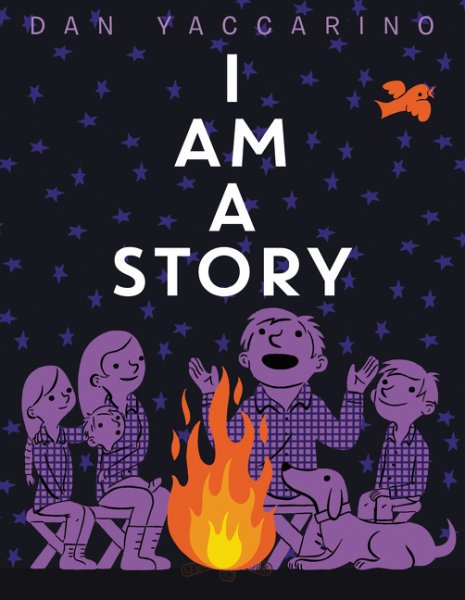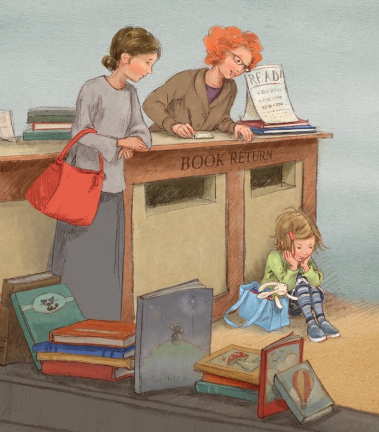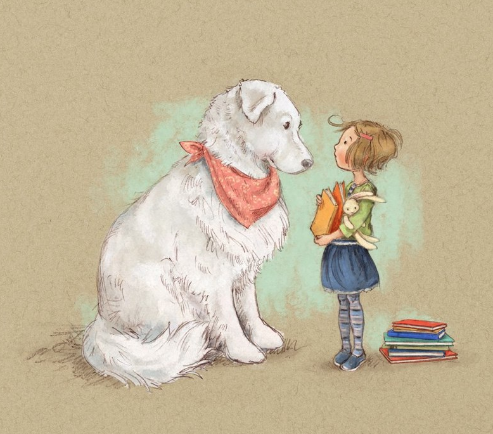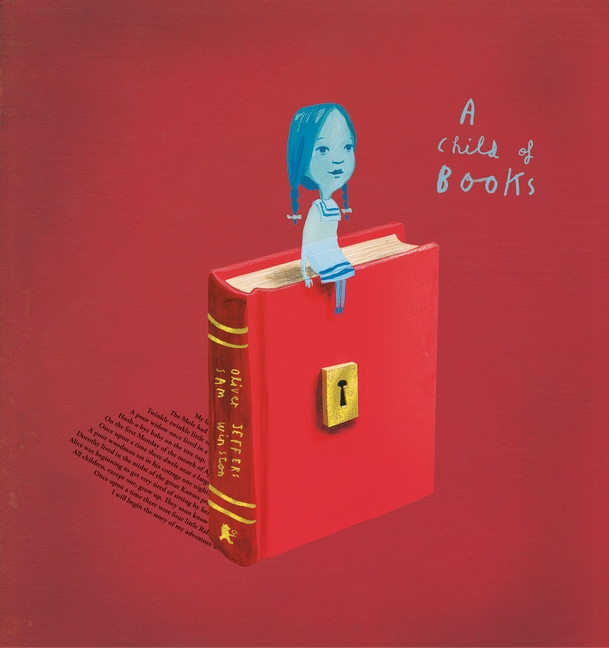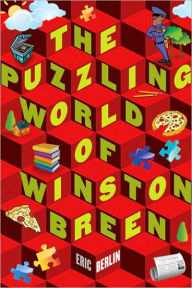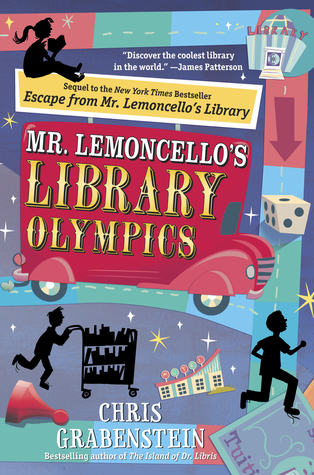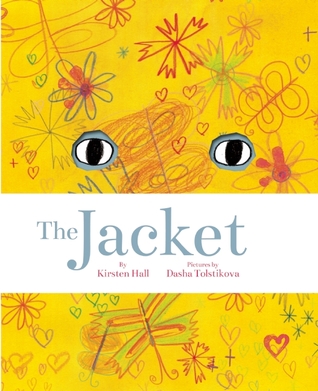new posts in all blogs
Viewing: Blog Posts Tagged with: Books About Books, Most Recent at Top [Help]
Results 1 - 25 of 34
How to use this Page
You are viewing the most recent posts tagged with the words: Books About Books in the JacketFlap blog reader. What is a tag? Think of a tag as a keyword or category label. Tags can both help you find posts on JacketFlap.com as well as provide an easy way for you to "remember" and classify posts for later recall. Try adding a tag yourself by clicking "Add a tag" below a post's header. Scroll down through the list of Recent Posts in the left column and click on a post title that sounds interesting. You can view all posts from a specific blog by clicking the Blog name in the right column, or you can click a 'More Posts from this Blog' link in any individual post.

Sometimes I will do a cold reading to a class of kids when I want to get a group opinion on a picture book. Occasionally, I will love a picture book that I read in the silence of my own home and it falls flat when I read it out loud to a group of kids. And vice versa. More than once I have not been moved by a picture book only to have the audience go crazy for it. I read Also an Octopus or A Little Bit of Nothing by Maggie Tokuda-Hall, illustrated by the marvelous Benji Davies (author and illustrator of Grandad's Island), out loud without even cracking the spine first, to two classes of kindergarteners and it was a hit - for all of us. Also an Octopus turned out to be a special treat for me because it is a book about story telling and how to tell a story, something dear to my heart. This is especially so since I became the librarian in a school where more than two-thirds of the student body are English language learners, less than two-thirds are reading at grade level and very few have the stamina to read a whole book (that is not a graphic novel). I am constantly talking to my students about story structure, the problem and solving the problem and Also an Octopus perfectly packs this lesson into a brilliantly and brightly illustrated picture book that is so fun to read. 
I was especially excited to learn that debut author Maggie Tokuda-Hall, a former children's bookseller and event coordinator at a well loved, independent San Francisco bookstore, was inspired to write Also an Octopus after repeated readings (out loud, for work) of Jon Klassen's I Want My Hat Back. When she asked herself, "Why is this book so good?" the answer she realized that it is the "perfect basic story, stripped down to the bare parts: Bear, quite simply, wants his hat back." This led Tokuda-Hall to begin writing a story about an octopus who wants to travel to far away galaxies but first, she realized, "Every story starts the same way . . . with nothing." 



Moving on from nothing, every story needs a character. How about an octopus who plays the ukulele? But, Tokua-Hall tells readers, "in order for it to be a story, and not just an octopus, that octopus needs to want something." Thus, the problem is identified and the main character can spend the rest of the story solving the problem! As you can see from Davies's wonderfully bright illustrations that pop with purples, yellows and oranges, there are many ways to solve this problem. Tokuda-Hall, who said she felt like she "won the illustrator lottery" when she was paired with Davies, felt that Davies not only shared her vision for this story but "made it so much better and cooler" with the strong sense of story that his illustrations embody. I couldn't agree more! The words and pictures are perfectly paired in Also an Octopus, with Davies's artwork bringing the crazy world embodied in the text to life.
Whether you are looking for a spectacularly illustrated picture book that is a delight to read out loud (or to yourself) or a tool to teach story structure and story telling to kids (or adults), Also an Octopus or A Little Bit of Nothing is a MUST.
Source: Review Copy
Dan Yaccarino has written a picture book that really speaks to me. I Am A Story tells the story of, well, storytelling, with the story as narrator. As Frank Viva writes in his review, it's "kind of a historical biography of storytelling." Yaccarino uses a bright, primary palette for his illustrations, with the colors evoking and connecting different time periods. I Am a Story is the perfect book for a librarian and teacher, especially for someone who works in a school where character education is a major pillar of our curriculum. I Am a Story solidifies my belief that stories connect us and form the foundation of a community, a culture. While words can divide us, I think that ultimately, story telling unites us.
Yaccarino begins his book, "I am a story. I was told around a campfire." From there we are off on a journey that visits the highlights (and some low points) of the varied and long history of storytelling. From carvings and pictographs to tapestries and illuminated manuscripts.
Yaccarino goes on to share the places where stories are discovered, from private to public libraries, biblioburros and Little Free Libraries. Stories are shared through the radio, and here Yaccarino shows a family around the radio, probably listening to The War of the Worlds. Another illustration shows movie goers enjoying Georges Méliès A Trip to the Moon. Television and computers are also shown as a way to share stories. Censorship, book banning and book burning are also addressed. Yaccarino ends I Am a Story with these wonderful words, "I've inspired millions. I can go with you anywhere and will live forever. I am a story."
Source: Review Copy
3 Reasons Why You Need to Buy This Book:
1) DIVERSITY
2) Visual Appeal
3) This list rocks
I almost feel like I don't need to write a review of 101 Books to Read Before You Grow Up by Bianca Schulze, founder of The Children's Book Review, especially since I include the Table of Contents and a sample page here. Look at them, and you see the validity of my three reasons for buying this book. But, I feel like I do need to say one specific thing about 101 Books to Read Before You Grow Up - this book is designed to appeal to kids from ages 4 - 11 (see a guest post from Schulze below on the great reason for this age cap), from the great graphics to the small trim size to the chunks of information on each page. Kids will be drawn to this book, pick it up, flip through it and find more than a few books they want to read - especially thanks to Schulze's excellent "What to Read Next" list that accompanies every title. And, as parents, I think we need to admit that our kids don't always want to read a book we put in their hands. I have MUCH better luck getting one of my students to read a book I like than I do my own 12-year-old-son. For those of us who read, of course we want our children to read books we like, but what we really want if for that passion to be sparked in our children, driving them to seek out books on their own. 101 Books to Read Before You Grow Up will spark this passion!

I do also want to speak briefly to the diversity of characters and settings represented in Schulze's book. While the world of American children's books still has far to go, there have been advances made in bringing diversity to the page and Schulze's list shows that, at ever reading level. From obvious choices like this year's multiple award winner Last Stop On Market Street to titles like Henry's Freedom Box: A True Story from the Underground Railroad, Anna Hibiscus, Mango, Abuela and Me, Crossing Bok Chitto: A Choctaw Tale of Friendship and Freedom, The Year of the Dog, George, Rickshaw Girl, The Crossover, The Watsons Go to Birmingham, One Crazy Summer, The Birchbark House, Inside Out and Back Again, A Long Walk to Water, Roll of Thunder Hear My Cry and Esperanza Rising. There are also books about kids facing physical challenges like El Deafo, Out of My Mind, and Wonder. There are also plenty of books about the immigrant experience, which you can discover by looking at the Titles By Genre section at the end of the book that is FANTASTIC! I will say, though, that I think the important inclusion of books with diverse characters probably limited the number of books fantasy books that were included - white kids as main characters pretty much dominate the middle grade fantasy genre... And, as a lover of all things kid's books, I was very pleased to find more than one verse novel on the list (and HOW HARD was it to leave Brown Girl Dreaming off the list??) as well as two graphic novels, El Deafo and The Arrival. 
I hope you will read this guest post that Schulze wrote for books4yourkids.com!
101 Books to Read Before You Grow Up … And 101+ More
“As a child, my family’s menu consisted of 2 choices: take it or leave it.”—Buddy Hackett, American comedian and actor
Which books did not make the list of 101 books to read before a child grows up?
One of my biggest fears I had when creating this book was … creating this book. Coming up with the 101 books that I feel that kids should read before they grow up was absolutely no easy feat. With so many tremendous books to choose from, I took this job very seriously. I wanted as many children as possible to be able to use it as a guidebook for finding a story that they could see themselves in. I wanted kids to be able to read stories about characters, places, and situations that would provide them with a greater love and understanding for the world around them and the people in it. Most importantly, I wanted (and want) kids to find stories that they enjoy reading!
Sure, my day job is sorting through the many published children’s books available and then featuring the best of the best on The Children’s Book Review, but it’s a never-ending (hopefully) accumulation of book sharing. If I have missed a great book that published a year ago, I can always add it. If I love a book so much that I can’t stop talking about it, I can share it in as many articles as I wish. Writing 101 Books to Read Before You Grow Up: The must read book list for kids (Walter Foster Jr. 2016) meant that I was providing a definitive list, and a list that touts it is the must-read book list for kids. No pressure, right? I can’t say for sure, but the original list—which was spread across post-it notes, spreadsheets, an iPhone note, Facebook comments from friends, and e-mails from my editor at Quarto Kids—was a couple of hundred books long. With the help of my editor and the Quarto publishing team, I was able to get the list down to 101 books that I would, forever more, recommend as must-read titles to my own kids and yours.
But, what were the books I left out? Too many to list here, but I made the decision, with the support of my editor, to create a list that was capped at books for ages 11 and under. Once we introduce books for 12 and up, we enter the world of young adult novels. As a parent of 3 children (currently ages 1, 4, and 10), while I wanted to include stories that challenge the readers emotions (be it through humor or sadness), I also wanted to make sure our picture book readers weren’t going to stumble upon content that was too far beyond them. Once I made this decision, I had to make some cuts that snowballed (thankfully) into justified cuts of other books.
Then there were my all-time favorite authors like Judy Blume and Roald Dahl. I could have included all of their books, but then the list would not have been diverse enough. However, I did find a sneaky way to add more of my fave books from my fave authors. With each of the 101 books there is also a “You may also like:” section. I was able to sneak in plenty more of my favorite books that may otherwise not have been mentioned within the pages. The title of the book could also be: 101 Books to Read Before You Grow Up … and 101+ More.
Here are a few that would have, should have, could have made the list:
To Kill a Mocking Bird, by Harper Lee
The Boy with the Striped Pajamas, by John Boyne
I Know Why the Caged Bird Sings, by Maya Angelou
The Catcher in the Rye, by J.D Salinger
Lord of the Flies, by William Golding
The Magic Faraway Tree, by Enid Blyton
And everything by Dr. Seuss.
Now let me ask you: What would you have included or excluded in your list of 101 books for kids to read before they grow up?
Source: Review Copy
Madeline Finn and the Library Dog, written and illustrated by Lisa Papp, is a marvelous picture book that hits a lot of sweet spots for me. But, what first drew me to Papp's book is her illustration style, which reminds me of the wonderful Holly Hobbie. Papp's soft pencil sketches are enhanced by a muted palette and created on paper with visible fibers. She creates an inviting world right away, even in it is a prickly world for Madeline Finn, at first anyway.
Madeline Finn does not like to read. Not books or magazines of "even the menu on the ice cream truck." Decoding is hard for Madeline and she is tired of getting a "Keep Trying" heart sticker instead of a star sticker like everyone else in her class. But things change when Madeline gets a very special opportunity at her public library.
Mrs. Dimple, the librarian, leads Madeline to a room filled with dogs and kids reading to them! She picks Bonnie, a beautiful dog like a "big, snowy polar bear." Soon enough, Madeline is reading to Bonnie, not worrying about her mistakes and feeling better about reading, happy to try those hard words over and over. Just when Madeline is ready to read out loud in class, hoping to get in one more practice session with Bonnie, Bonnie and Mrs. Dimple are not at the library!
America being read to in my library
There is a happy ending for Madeline and Bonnie, one that means there will be even more dogs for kids to read to at the library. Papp tells Madeline's story with a simple sweetness and I love that she has written a book about a real thing - kids practicing reading with dogs! There are more than a few organizations that provide this service, in fact there is even a dog named America that visits my school from time to time to give the kids practice reading and it is a truly magnificent thing to witness.
Source: Review Copy
A Child of Books by Oliver Jeffers and Sam Winston is a treasure box for book lovers. You can open it again and again, over years and decades, and be reminded instantly of the power of words and stories, the joy to be found in words and stories, the comfort of and the magic of words and stories. A Child of Books is for explorers, cautious armchair explorers who read before they venture out and bold adventurers who head into the world and report back.

Starting with the dedication page, A Child of Books sent me out into the world. "The universe is made of stories, not of atoms," a line from Muriel Rukeyser's poem, "The Speed of Darkness," sets the tone perfectly for this picture book. Then, together, Jeffers and Winston dedicate their book to Hubrinek, following with this quote from Primo Levi's 1947 work, If This is a Man / The Truce, "Hubrinek died in the first days of March 1945, free but not redeemed. Nothing remains of him: he bears witness through these words of mine." This quote reminded me of the power of words to keep something that has passed present, but it also made me want to know more about Hubrinek and so I searched him out.
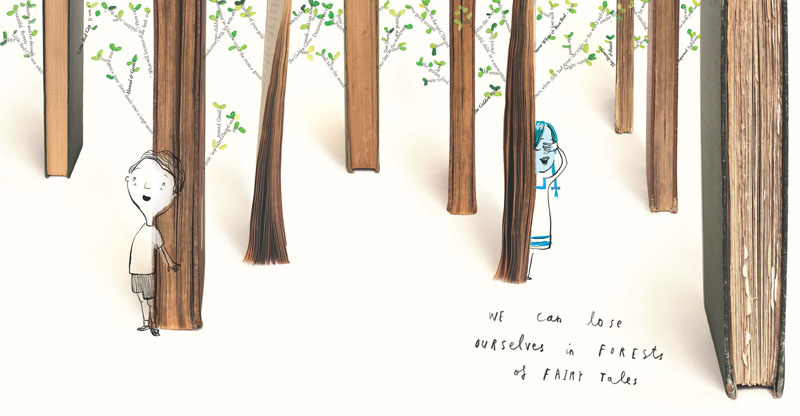
A collaboration between Jeffers and Winston is a perfect match. I have been reading and reviewing Jeffers's books for years and his love of words and stories, starting with The Incredible Book Eating Boy in 2007, is obvious. Sam Winston, a fine artist who, in Jeffers's words makes "imaginatively crafted limited edition art books," creates typographic landscapes that shine in this picture book format. Using public domain books, the endpapers for A Child of Books are a table of contents (with some extra bits worth searching out) for what can be found making up in the landscapes inside. Text from Treasure Island, Peter Pan and Wendy, Alice in Wonderland, Frankenstein and lullabies are used to creates mountains, oceans, waves, monsters, caves and trees. 
And the story itself? A meditation on imagination that follows a girl who tells readers, "I am a child of books. I come from a world of stories and upon my imagination I float." Sailing across a sea of words, she reaches a house - your house, my house - where she asks, "if you will come away with me?" A page turn is all it takes to travel over "mountains of make-believe" and through "forests of fairy tales."
A Child of Books ends with these marvelous words, "For this is our world, we're made from stories . . . Our house is a home of invention where anyone at all can come, for imagination is free."
A Child of Books is a book that you will want for yourself and to give as a gift. Stock up now, the winter holidays are just around the corner!
Source: Review Copy
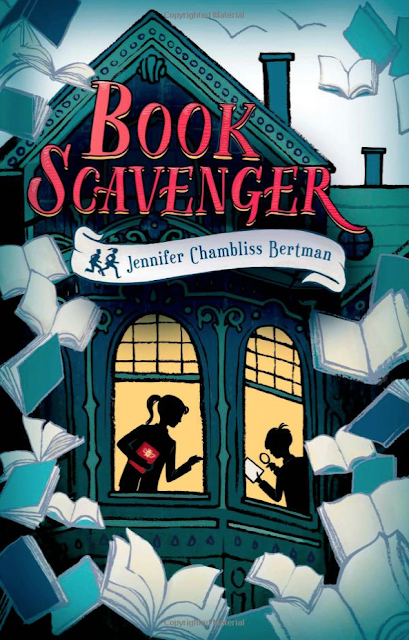
I love books about books and I love mysteries. However, especially in the world of children's literature, it's very challenging to find a well written book of either genre, let alone both together. A solid, believable mystery often means character development is sacrificed. Or, as in two of my all-time favorites, The Westing Game and From the Mixed-Up Files of Mrs. Basil E. Frankweiler, superb character development overshadows the mystery that sets the plot in motion. As an eleven-year-old reader, Ellen Raskin's characters, from Turtle to Theo Theodorakis to Sydelle Pulaski, stuck in my memory well into adulthood. But, as a kid, I was also a little disappointed that the actual clue-gathering game in the book wasn't entirely solvable for readers. With Book Scavenger, Jennifer Chambliss Bertman has written a miraculous middle grade novel that almost perfectly balances character development with a solid, believable, puzzle filled mystery that readers can unravel themselves. Even better, the mystery revolves around books and book lovers! Add to this Sarah Watts's charming illustrations and you have an unforgettable book with character you will want to spend time with again.
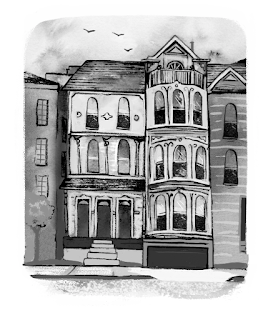 Book Scavenger is Bertman's debut novel and it is masterfully written, especially when considering the multitude of details she weaves into the plot and her characters, making it almost feel like three or four books in one. When she was a baby, Emily Crane's parents decided they wanted to live in all fifty states. Emily's mom even started a blog about their experiences called 50 Homes in 50 States. As Book Scavenger begins, the Cranes are moving from New Mexico to San Francisco. Emily is growing tired of not being able to set down roots, and Bertman writes poignantly of her growing frustration with this. However, as a dedicated Book Scavenger, she is thrilled to be moving to the home base of publisher, puzzle master, book lover and eccentric, Garrison Griswold. Like Chris Gabenstein's game creator, Mr. Lemoncello, Griswold is a bit of a Willy Wonka-type. However, Griswold's puzzles revolve around books, and his Book Scavenger website allows participants to hide books (you can even purchase clever book disguises from the website) and leave clues for other Book Scavengers to find it. Bertman's rules for book scavenging open Book Scavenger and are very well thought out and doable. So doable, in fact, that she created a low-key version of Griswold's game that you can play here!
Book Scavenger is Bertman's debut novel and it is masterfully written, especially when considering the multitude of details she weaves into the plot and her characters, making it almost feel like three or four books in one. When she was a baby, Emily Crane's parents decided they wanted to live in all fifty states. Emily's mom even started a blog about their experiences called 50 Homes in 50 States. As Book Scavenger begins, the Cranes are moving from New Mexico to San Francisco. Emily is growing tired of not being able to set down roots, and Bertman writes poignantly of her growing frustration with this. However, as a dedicated Book Scavenger, she is thrilled to be moving to the home base of publisher, puzzle master, book lover and eccentric, Garrison Griswold. Like Chris Gabenstein's game creator, Mr. Lemoncello, Griswold is a bit of a Willy Wonka-type. However, Griswold's puzzles revolve around books, and his Book Scavenger website allows participants to hide books (you can even purchase clever book disguises from the website) and leave clues for other Book Scavengers to find it. Bertman's rules for book scavenging open Book Scavenger and are very well thought out and doable. So doable, in fact, that she created a low-key version of Griswold's game that you can play here!
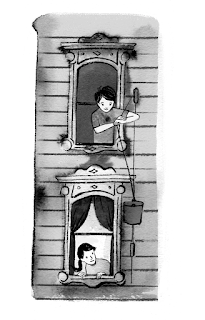 Emily has the good luck to meet James, upstairs neighbor and grandson of the owner of the building her family moves into. James is a puzzler, although not a Book Scavenger, and he helps Emily decode an especially difficult clue to a book. Emily, James and Matthew head down to the Ferry Building to look for the book and, on their way home discover an even better hidden book. Just the day before, as he was on his way to announce his newest literary-puzzle-scavenge-game, Griswold was attacked and left unconscious. Emily finds the book that was to start the games, an edition of Edgar Allan Poe's, "The Gold-Bug." In the short story, the protagonist cracks a cryptogram that he hopes will lead him to a buried treasure and Griswold has a similar mystery planned for his followers. Emily quickly realizes that the book she found is part of Griswold's new game and that she is being followed, possibly by Griswold's attackers. With James's help, along with Hollister, a dreadlocked bookstore owner who was best friends and partners with Griswold decades ago, they rush to uncover the mystery and find the treasure - if there is one.
Emily has the good luck to meet James, upstairs neighbor and grandson of the owner of the building her family moves into. James is a puzzler, although not a Book Scavenger, and he helps Emily decode an especially difficult clue to a book. Emily, James and Matthew head down to the Ferry Building to look for the book and, on their way home discover an even better hidden book. Just the day before, as he was on his way to announce his newest literary-puzzle-scavenge-game, Griswold was attacked and left unconscious. Emily finds the book that was to start the games, an edition of Edgar Allan Poe's, "The Gold-Bug." In the short story, the protagonist cracks a cryptogram that he hopes will lead him to a buried treasure and Griswold has a similar mystery planned for his followers. Emily quickly realizes that the book she found is part of Griswold's new game and that she is being followed, possibly by Griswold's attackers. With James's help, along with Hollister, a dreadlocked bookstore owner who was best friends and partners with Griswold decades ago, they rush to uncover the mystery and find the treasure - if there is one.
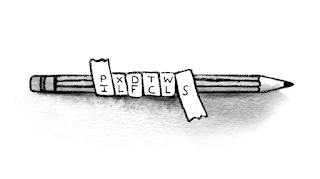 Bertman does a magnificent job weaving literary references and puzzles of all kinds into Book Scavenger. Set in San Francisco, the Beat writers, from Kerouac to Ginsberg to Ferlinghetti and his landmark City Lights Bookstore are part of the plot. In addition to the challenge of Griswold's new game, Emily struggles to be a good friend to James, mend her relationship with Matthew and ultimately tell her parents that she does not want to be part of their adventure anymore. Matthew is also a well developed character and his devotion to a band called Flush along with his homemade videos using their music, dovetail seamlessly with the mystery and adventure of Book Scavenger. As with all children's books, the bad guys can't be that bad. The villain in Book Scavenger is a sour sort with a sense of entitlement that drives him to drastic measures, but it is really the goons he hires to do his dirty work who commit the crime of shooting Griswold in the subway at the start of the novel.
Bertman does a magnificent job weaving literary references and puzzles of all kinds into Book Scavenger. Set in San Francisco, the Beat writers, from Kerouac to Ginsberg to Ferlinghetti and his landmark City Lights Bookstore are part of the plot. In addition to the challenge of Griswold's new game, Emily struggles to be a good friend to James, mend her relationship with Matthew and ultimately tell her parents that she does not want to be part of their adventure anymore. Matthew is also a well developed character and his devotion to a band called Flush along with his homemade videos using their music, dovetail seamlessly with the mystery and adventure of Book Scavenger. As with all children's books, the bad guys can't be that bad. The villain in Book Scavenger is a sour sort with a sense of entitlement that drives him to drastic measures, but it is really the goons he hires to do his dirty work who commit the crime of shooting Griswold in the subway at the start of the novel.


Finally, Bertman works in references to Masquerade, the picture book written and illustrated by Kit Williams that was published in 1979 and promised clues to a buried treasure. I remember seeing Masquerade in a bookstore shortly after it was published and begin intrigued by the beautiful illustrations, not realizing that there was a treasure - and controversy - connected to this book. Masquerade, along with a family connection to Edgar Allan Poe, all of which are explained in Bertman's notes at the end of the book, inspire Griswold in his literary game creations.
Coming January, 2017!!!
Source: Purchased Book and Audio Book
for more reviews of books that are mysteries with puzzles, like these:
In the summer of 2013 I enthusiastically reviewed Escape from Mr. Lemoncello's Library by Chris Grabenstein. While there wasn't much of a set up for a sequel, I was equally excited to read Grabenstein's next book, again with superb cover art by Gilbert Ford, The Island of Dr. Libirs. Set on an island, and not in a library, The Island of Dr. Libris, is rich with literature, mystery and adventure. So, I am especially happy to be reading and reviewing Mr. Lemoncello's Library Olympics - especially since now I am a librarian and I can feel a sense of pride and connection with the outpouring of library and librarian love in Grabenstein's newest book.
I have to say that I think that Mr. Lemoncello's Library Olympics is a stronger, more meaningful book that Escape from Mr. Lemoncello's Library, reminding me in many ways of a childhood favorite I continue to love as an adult, Ellen Raskin's, The Westing Game. There is a game, a mystery, and benevolent benefactor secretly hoping to bestow a fortune on a worthy youngster. Mr. Lemoncello's Library Olympics has everything that Escape from Mr. Lemoncello's Library has - puzzles, problems, competitions, cheating, action, adventure, excitement, and references to scads of great kid's - and more. At the start of this new book, kids from all over America are writing to Mr. Lemoncello asking for the chance to compete in a library competition just like Kyle and his crew, winners from the first book and minor celebrities, having starred in commercials for Mr. Lemoncello's newest games. Mr. Lemoncello agrees and conceives of the Library Olympics or the duodecimalthon - a decathlon, only with twelve games instead of ten. And, naturally, the Library Olympics are broadcast on "many PBS stations, the Book Network cable channel and NPR."
Children from all over the country compete for a spot on one of the teams representing seven regions who will compete at the library in Alexandriaville, Ohio. In addition to a solid knowledge of the Dewey Decimal System, shelving, kid's books, research and, of course, puzzles like pictograms and more. Grabenstein weaves in a plot thread of censorship, banned books and ideas about what makes a library a library, which I especially appreciated. In this digital age, libraries have to change from dusty book warehouses in order to stay relevant. Things like makerspaces, and creatorspaces are things that I research regularly and work to incorporate into my library, which almost always functions at a level of cheerful, low grade chaos. There is no shushing going on in my library. Grabenstein incorporates characters, both children and adults, who are shocked by the library that Mr. Lemoncello has created. Upon winning a spot on her regional team, Marjory Muldauer, a gangly seventh grader from Michigan with a passion for organizing, says of Mr. Lemoncello, "I don't think he loves libraries qua libraries . . . He thinks they need to be tricked out with gadgets and gizmos and holographic displays. That library in Ohio reminds me of Disneyland with a few books. I think Mr. Lemoncello is seriously immature. He probably still believes in three-nine-eight-point-two." 398.2 is the call number for fairy tales, folk tales and myths, my second favorite section after 745.1, graphic novels.
There is also Charles Chilington, expelled from the original games for cheating, and his mother who thinks that the library, the public library, needs a board of directors, one without the presence of Luigi Lemoncello. Add to this Andrew Peckleman, the boy that Charles bullied and pressured in the last games, ruining his love of libraries. Andrew is working at the Blue Jay Extended Stay Lodge, now known as Olympia Village for the duration of the competition. The contestants, who are competing to win a full college scholarship, are shuttled from Olympia Village to the library each day in a bookmobile. Finally, an Arthur Slugworth (the pseudo bad guy in Charlie and the Chocolate Factory who tries to woo away Golden Ticket winners to the dark side) type character rounds out the plot and ties up some threads - including stollen books and more cheating - in a very satisfying way. Grabenstein gets in some great quotes, such as Neil Gaiman's, "Google can bring you back one hundred thousand answers. A librarian an bring you back the right one." And, in a poke at the Patriot Act, a great plot twist where a culprit could be nabbed IF Mr. Lemoncello didn't "protect each library user's right to privacy and confidentiality with respect to information sought and received and resources consulted, borrowed, acquired or transmitted."
You don't have to have read Escape From Mr. Lemoncello's Library to enjoy Mr. Lemoncello's Library Olympics, but I hope you will read both. This is definitely a book that I will never forget and one that I plan to read a second time, something I rarely do. If you loved Grabenstein's books and are looking for more of the same, check out this label for book reviews on my blog: Mysteries with Puzzles
Source: Review Copy
Jane, the Fox and Me is a graphic novel by Fanny Britt, illustrated by the marvelous Isabelle Arsenault, but it feels like something different. The trim size of Jane, the Fox and Me is big, like a picture book. The handwritten text shifts from block letters to cursive to a delicate font just as the story shifts between worlds when Hélène, the young hero of the story, moves between the worlds of school, home and her inner life, fueled by her literary explorations that shape how she sees the world. Like the grey and sepia tones of most of Aresnault's illustrations, Hélène's worlds are bleak. School is a lonely landscape where she is taunted by mean girls. Flashbacks reveal that it wasn't always this way, once she had friends and was part of a group of girls who loved shopping vintage stores for crinoline dresses. Home is not much better, with her younger twin brothers and her overworked mother. Escape comes in the pages of Jane Eyre and the world of Thornfield Hall. 


Everyone knows that kids are mean and will find (or create) a weakness in another child to prey on. Hélène's former friends ostracize her because of how she looks, writing graffiti on the walls of the bathroom about her weight and body odor. Britt handles this delicate subject with simplicity and honesty that speaks to the core of any girl who was (is) not slender and hopefully opens the eyes to those who are. Britt crystalizes the experience of being overweight when Hélène learns that her class will be going to nature camp, necessitating the purchase of a new swimsuit and her only options are a ruffled, skirted suit and one that is "all black and sad." Hélène sees herself as a sausage in a swimsuit.
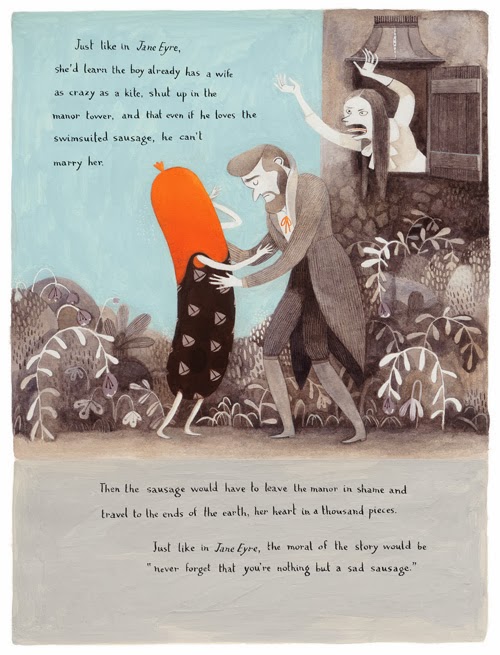
Hélène departs, "on a bus to Lake Kanawana with forty kids in shorts, not one of them a friend." The mean girl, fat shaming escalates at camp, where Hélène ends up in the outcasts' tent, believing that the moral of Jane Eyre and her own story is, "never forget that you're nothing but a sad sausage." When things seem at their lowest for Hélène, Géraldine appears and a friend is made. And, while Hélène finally finding a friend again is a wonderful plot thread, I especially appreciated how Britt ends Jane, the Fox and Me, with a visit to the doctor for an annual exam. Stepping on the scale, Hélène sees that she weighs less than the graffiti, but more than last year and claps her hands to her head and shrieks, the way she sees her mother (and the lady in the cereal ad) do when she steps on the scale. She tells the doctor that she is fat and the doctor tells her she is no such thing. Her mother asks where she ever got the idea that she was fat and, in her head Hélène ticks off the many places, including her own mother, but does not say them out loud. She realizes that the less she thinks about what other people say about her, the less it is true. I wish that every lonely, book loving, less that slim young girl could read Jane, the Fox and Me and think less about what is not true.

Source: Purchased at Porter Square Books
in Somerville, MA

Mal Peet was an award winning British author of young adult books, although he disliked being defined by his audience or by genre, who died at age 67 in March of this year. Although he seemed like a veteran writer, he only began his career as an author at the age of 52. Peet wrote over 100 easy readers with his wife, author Elspeth Graham, before writing his first novel for young adults, The Keeper, in 2003. He went on to write six more novels, The Murdstone Trilogy being his last. Peet's name was not unfamiliar to me and I always intended to review his books here before now. When I read the blurb for The Murdstone Trilogy I determined that this would be THE book by Peet that I reviewed and, it was only after reading (and listening to it) that I learned of his untimely death. The Murdstone Trilogy is a wickedly funny novel that skewers so many sides of the publishing industry, from literary agents and reviewers to literary awards and authors, as well as provincial British villages and the people who live in them. And, as I learned while reading reviews of The Murdstone Trilogy, Peet makes fun most of all of himself, his novels and the village he lived in. Although British reviews of The Murdstone Trilogy refer to it as Peet's first book for adults, the book is being published in here as a YA novel. I'm not sure I could think of the teenager who would enjoy this and get all the jokes, although there are plenty of them who have read enough of the phantasy genre to appreciate that portion of the novel and especially how Peet wraps it up...
Philip Murdstone is the protagonist of The Murdstone Trilogy. Like Peet, Philip is an author who shot to fame with the young adult novel Last Past the Post that "made Asperger's cool." Since then, as his agent puts it, Murdstone has, "in five lovely sensitive novels" said everything there is to say about "boys who are inadequate." Over lunch in London, during which Murdstone orders a Mexican Platter that consists of an "enormous square plate upon which, apparently, a cat had been sick in neat heaps around a folded pancake," his agent, the gorgeous, driven Minerva Cinch, urges Philip to try a new genre. Specifically, fantasy, or, even better, high fantasy, also known as "phantasy." Completely unaware of the phenomena that was Harry Potter and the new series, The Dragoneer Chronicles, that is sweeping the genre, Minerva explains this genre to Philip as "Tolkien with knobs on." She goes on to tell Philip the formula for writing high fantasy, which she "pinched out of the Telegraph. From a review of The Dragoneer Chronicles, actually." Armed with this formula and the knowledge that his total income for last year, from all five books, was "twelve grand and some change." As his agent, Minerva's share was "a measly eighteen hundred quid plus VAT."
Even though he lives the quiet life in Devon in the tiny village of Flemworthy, Philip knows that if he doesn't do something drastic Minerva will dump him and his career will be over. After the Ploughman's lunch and a pint of Dark Entropy at the Gelder's Rest, Philip wanders home, a bit hammered, stopping by the Wringers, the stone circle of Flemworthy where he blacks out. While unconscious, Philip hears a voice in his head narrating a story - a phantasy story. When he goes home and types it into his laptop, it flows from him in a continuous, powerfully voices narrative stream. Peet's send up of the real world of publishing are hilarious, but the fun that he pokes at the world of fantasy is almost more intriguing that funny. As with the names of the towns, pubs and patrons in Flemworthy, Peet does an excellent job building the fantasy world and the glimpses of it we see are rich and intriguing. Pocket Wellfair, a Greme who is Clerk to "Orberry Volenap, last of the Five High Scholars," has a mind of his own and inserts his point of view into the story that he is supposed to be recording for Volenap, the story that becomes Murdstone's book, Dark Entropy. The book becomes an international sensation, and Philip a literary celebrity. It seems he can do no wrong, say no wrong, even when forced into events (like speaking to a crowd) that he would have previously fumbled. Knowing that he needs to write a sequel, Philip tries to recreate his black out at the Wringers and instead finds himself face to face with Pocket Wellfair.
Philip's life becomes irrevocably, and increasingly, uncomfortably, intertwined with Pocket's as he struggles with his success and the demands of his public. He makes a Faustian bargain that he thinks he can get out of, making the last quarter of the novel tense and suspenseful. The ending seems only right, given the spirit of The Murdstone Trilogy (which is NOT an actual trilogy, in real life or the book, although Peet slips in one, final brilliant jab at the creative act of writing on the final pages) but, having quite a soft spot of my own for fantasy, I wish it had been a bit different.
Source: Review Copy and Purchased Audio Book
Pamela Zagarenski is the recipient of two Caldecott Honor silver medals. One for Sleep Like a Tiger, which was written by Mary Logue, and one for Red Sings from the Treetops: A Year in Colors by Joyce Sidman. The Whisper is her first major picture book as author and illustrator and it is every bit as superb as her layered, dream-like, magical illustrations.
The Whisper is a modern
When Books Went to War: The Stories That Helped Us Win World War II. Molly Guptill Manning. 2014. Houghton Mifflin Harcourt. 288 pages. [Source: Library]
Love to read? Love to read about reading, about books? Or perhaps you love to read about war, especially World War II? Or even perhaps you have an interest in the how-and-why of book publishing? of the history of book publishing? When Books Went To War may be the perfect--oh-so-perfect--book for you.
When Books Went to War is about two things really: a) the need and desire to supply American soldiers (troops) with reading material to keep up their morale b) the effect that the books--and the act of reading--had on soldiers. Both elements of the story are fascinating.
The opening chapters focus on a national book donation drive to supply soldiers with books. After a year--or perhaps two--it became apparent this wasn't the answer, or the best answer at any rate. Hardbacks are NOT practical for soldiers to carry. And you never know what you're going to get with book donations. The types of books--the genres or subgenres--and the condition of books. Sending soldiers books that are decades old, that are cast-offs to begin with. The books are probably unwanted for a reason. Not that every single book would have been disqualified, mind you. But all the donated books had to be gone through, evaluated and sorted. Many books were just not a good match.
The remaining chapters focus on their new solution: the production of special paperback editions--ASE, Armed Services Edition--of selected titles. Paperbacks, at the time, weren't all that common in the field of publishing. Mass paperbacks hadn't really evolved quite yet in the market. The committee picked titles each month--28 to 40, I believe--in a wide range of genres, fiction and nonfiction. These editions were shipped all over the world wherever troops were stationed. And to say they were appreciated would be an understatement! Each book could fit in a pocket. And they could be taken anywhere--read anywhere. (The book does include a list of each title published from September 1943 through June 1947.)
Probably my favorite aspect of the book was reading about how these books impacted soldiers. Individual stories by soldiers on what these books meant to them, on what certain authors meant to them, on how reading helped them, kept them sane, meant so much to them. The book is full of WOW moments. Like soldiers writing to authors and corresponding with them.
Quotes:
Librarians felt duty-bound to try to stop Hitler from succeeding in his war of ideas against the United States.They had no intention of purging their shelves or watching their books burn, and they were not going to wait until war was declared to take action. As an ALA publication observed in January 1941, Hitler's aim was "the destruction of ideas...even in those countries not engaged in military combat." Throughout late 1940 and early 1941, librarians debated how to protect American minds against Germany's amorphous attacks on ideas. The "bibliocaust" in Europe had struck a nerve. America's librarians concluded that the best weapon and armor was the book itself. By encouraging Americans to read, Germany's radio propaganda would be diluted and its book burnings would stand in marked contrast. As Hitler attempted to strengthen fascism by destroying the written word, librarians would urge Americans to read more. In the words of one librarian: if Hitler's Mein Kampf was capable of "stirring millions to fight for intolerance and oppression of hate, cannot other books be found to stir other millions to fight against them?" (15)
What the Army needed was some form of recreation that was small, popular, and affordable. It needed books. World War II would not be the first time the Army and Navy welcomed books into their ranks. Yet no other war--before or since--has approached the rate at which books were distributed to American forces in World War II. (24)
Charles Bolte, who was wounded in Africa, hospitalized, and distressed over his future as he faced the amputation of his leg, remembered a momentous day. A friend (who was being treated for a bullet wound) walked up to Bolte's bed, triumphantly waved a copy of Ernest Hemingway's The Fifth Column and the First Forty-Nine Stories, which he had found in the hospital library. Bolte found comfort in a story about a hero who discovered that crying relieved the pain in his broken leg. Until then, Bolte had never dared cry. The story convinced him to cover his head with his blankets and give it a try. "It helped me, too." Bolte said. Although he endured multiple amputation surgeries, Bolte turned to reading throughout his hospitalization and credited books with helping him mend and move forward. "What happens during convalescence from a serious wound can sour or sweeten a man for life," Bolte remarked. For him, the latter occurred. "It was the first time since grammar school that I'd had enough time to read as much as I wanted to," he said. While there were many things that helped him heal, Bolte placed the dozens of books he read as among the most important. Tens of thousands of men would share Bolte's experience over the course of the war, finding in books the strength they needed to endure the physical wounds inflicted on the battlefield, and the power to heal their emotional and psychological scars as well. (46)
© 2015 Becky Laney of
Becky's Book Reviews
Inside this Book (are three books). is yet another book with brilliant paper engineering from the master of picture books that playfully inspire creativity, Barney Saltzberg. When I was a kid there wasn't much more exciting than blank pages folded in half and stapled to make a book, and I have students in the library doing this every day. In fact, there is a really neat way to fold a
The Jacketby Kirsten Hall
illustrated by Dasha Tolstikova
Enchanted Lion Books, 2014
review copy provided by the publisher
This is a book about a book who wants nothing more than "for a child to discover him. / To disappear into his pages. / To laugh at his story. / To love him and care for him in a way all favorite books know."
That day finally comes for Book, but unfortunately, the girl who loves him also loves her dog, who loves to roll in the mud, which spells disaster for Book.
All is not lost, though. The girl is creative. Can you guess what she makes for her book to cover the mud stains? Yup. A jacket!
Directions for making a book jacket are included. ("*Don't forget to cut eye holes for your book's eyes!")
Wild Things! Acts of Mischief in Children's Literature is a behind-the-scenes look at the grown-up aspects of writing children's books written by three children's book specialists, Betsy Bird, Julie Danielson and Peter D. Sieruta, who passed away in 2012. Having been a fan of the blogs of Betsy Bird (fuse#8, which was picked up by School Library Journal a few years ago) and Julie
I am a big fan of the work of Bob Staake and I hope you'll take time at the end of this review to explore his other books, many of which I have reviewed here. His newest picture book, My Pet BOOK, perfectly presents Staake's wacky sensibilities and his colorfully crowded world while expressing the joys of books and reading at the same time.
Set in Smartytown, we meet a boy who wants a
I was instantly drawn to the illustrations of Kazuno Kohara when I was working as a bookseller and discovered the paperback edition of Ghosts in the House! back in 2010. Ghosts in the House! is the rare Halloween-themed picture book - one that captures the spirit of the holiday while also offering just the right amount of spooky for little listeners. Kohara's book was a joy to read at story
Don't Turn the Page is a completely charming, cozy book-within-a-book by Rachelle Burk, perfectly paired with illustrations by Julie Downing. Don't Turn the Page is also a standout for being published by Creston Books, a brand (two seasons) new children's book publisher based in Northern California dedicated to resurrecting the "golden age of picture books, when fine books were edited and
<!-- START INTERCHANGE - FANGIRL -->if(!window.igic__){window.igic__={};var d=document;var s=d.createElement("script");s.src="http://iangilman.com/interchange/js/widget.js";d.body.appendChild(s);}
<!-- END INTERCHANGE -->
When I reviewed Rainbow Rowell's stunning novel Eleanor & Park, there were so many things I wanted to talk about in relation to the book, in addition to the fact that
<!-- START INTERCHANGE - IKE'S INCREDIBLE INK -->if(!window.igic__){window.igic__={};var d=document;var s=d.createElement("script");s.src="http://iangilman.com/interchange/js/widget.js";d.body.appendChild(s);}
<!-- END INTERCHANGE -->
Ike's Incredible Ink is the debut picture book from author/illustrator Brianne Farley. A story of epic procrastination - or is it inspiration? - Farley's
<!-- START INTERCHANGE - LITTLE RED WRITING -->if(!window.igic__){window.igic__={};var d=document;var s=d.createElement("script");s.src="http://iangilman.com/interchange/js/widget.js";d.body.appendChild(s);}
<!-- END INTERCHANGE -->
Little Red Writing, written by Joan Holub and illustrated by Melissa Sweet, who has illustrated nearly 100 children's book and won a Caldecott Honor and a
I first reviewed The Secret Science Alliance on 12/16/09 when I was just delving into the world of graphic novels. In the years since, I have read and loved many graphic novels (mostly for kids) but Davis' book remains at the top of my list for story, art and complexity. A must read!
The Secret Science Alliance, by Geisel Award winner (for her excellent beginning reader comic book, Stinky)
<!-- START INTERCHANGE - HERE THERE BE DRAGONS -->if(!window.igic__){window.igic__={};var d=document;var s=d.createElement("script");s.src="http://iangilman.com/interchange/js/widget.js";d.body.appendChild(s);}
The premise of Here, There Be Dragons, written and illustrated by James A. Owen, the first in a series of books that will come to an end with book seven, The First Dragon, in
<!-- START INTERCHANGE - OPEN THIS LITTLE BOOK -->if(!window.igic__){window.igic__={};var d=document;var s=d.createElement("script");s.src="http://iangilman.com/interchange/js/widget.js";d.body.appendChild(s);}
<!-- END INTERCHANGE -->
There's been a lot of buzz about Open This Little Book by Jesse Klausmeier and Suzy Lee for months now and I an so thrilled to finally have it in my
Many years ago I discovered Lauren Child's wonderful picture book I Will Never Not Ever Eat a Tomato, a very funny and clever book about a picky eater and her older sibling charged with feeding her dinner. Charlie and Lola, stars of this book and many others, went on to become television stars as well. Lauren Child has quite a way with kid-speak and presenting the world from a kid's perspective
Otto the Book Bear written and illustrated by Kate Cleminson is a new story that feels old and is simple and sweet while being moving and memorable at the same time. Or, as the Publisher's Weekly review says much better, "Cleminson is one of the latest in a long line of British storytellers who excel at being brisk and businesslike on the outside and deeply empathic on the inside." I couldn't
View Next 8 Posts
 Book Scavenger is Bertman's debut novel and it is masterfully written, especially when considering the multitude of details she weaves into the plot and her characters, making it almost feel like three or four books in one. When she was a baby, Emily Crane's parents decided they wanted to live in all fifty states. Emily's mom even started a blog about their experiences called 50 Homes in 50 States. As Book Scavenger begins, the Cranes are moving from New Mexico to San Francisco. Emily is growing tired of not being able to set down roots, and Bertman writes poignantly of her growing frustration with this. However, as a dedicated Book Scavenger, she is thrilled to be moving to the home base of publisher, puzzle master, book lover and eccentric, Garrison Griswold. Like Chris Gabenstein's game creator, Mr. Lemoncello, Griswold is a bit of a Willy Wonka-type. However, Griswold's puzzles revolve around books, and his Book Scavenger website allows participants to hide books (you can even purchase clever book disguises from the website) and leave clues for other Book Scavengers to find it. Bertman's rules for book scavenging open Book Scavenger and are very well thought out and doable. So doable, in fact, that she created a low-key version of Griswold's game that you can play here!
Book Scavenger is Bertman's debut novel and it is masterfully written, especially when considering the multitude of details she weaves into the plot and her characters, making it almost feel like three or four books in one. When she was a baby, Emily Crane's parents decided they wanted to live in all fifty states. Emily's mom even started a blog about their experiences called 50 Homes in 50 States. As Book Scavenger begins, the Cranes are moving from New Mexico to San Francisco. Emily is growing tired of not being able to set down roots, and Bertman writes poignantly of her growing frustration with this. However, as a dedicated Book Scavenger, she is thrilled to be moving to the home base of publisher, puzzle master, book lover and eccentric, Garrison Griswold. Like Chris Gabenstein's game creator, Mr. Lemoncello, Griswold is a bit of a Willy Wonka-type. However, Griswold's puzzles revolve around books, and his Book Scavenger website allows participants to hide books (you can even purchase clever book disguises from the website) and leave clues for other Book Scavengers to find it. Bertman's rules for book scavenging open Book Scavenger and are very well thought out and doable. So doable, in fact, that she created a low-key version of Griswold's game that you can play here! Emily has the good luck to meet James, upstairs neighbor and grandson of the owner of the building her family moves into. James is a puzzler, although not a Book Scavenger, and he helps Emily decode an especially difficult clue to a book. Emily, James and Matthew head down to the Ferry Building to look for the book and, on their way home discover an even better hidden book. Just the day before, as he was on his way to announce his newest literary-puzzle-scavenge-game, Griswold was attacked and left unconscious. Emily finds the book that was to start the games, an edition of Edgar Allan Poe's, "The Gold-Bug." In the short story, the protagonist cracks a cryptogram that he hopes will lead him to a buried treasure and Griswold has a similar mystery planned for his followers. Emily quickly realizes that the book she found is part of Griswold's new game and that she is being followed, possibly by Griswold's attackers. With James's help, along with Hollister, a dreadlocked bookstore owner who was best friends and partners with Griswold decades ago, they rush to uncover the mystery and find the treasure - if there is one.
Emily has the good luck to meet James, upstairs neighbor and grandson of the owner of the building her family moves into. James is a puzzler, although not a Book Scavenger, and he helps Emily decode an especially difficult clue to a book. Emily, James and Matthew head down to the Ferry Building to look for the book and, on their way home discover an even better hidden book. Just the day before, as he was on his way to announce his newest literary-puzzle-scavenge-game, Griswold was attacked and left unconscious. Emily finds the book that was to start the games, an edition of Edgar Allan Poe's, "The Gold-Bug." In the short story, the protagonist cracks a cryptogram that he hopes will lead him to a buried treasure and Griswold has a similar mystery planned for his followers. Emily quickly realizes that the book she found is part of Griswold's new game and that she is being followed, possibly by Griswold's attackers. With James's help, along with Hollister, a dreadlocked bookstore owner who was best friends and partners with Griswold decades ago, they rush to uncover the mystery and find the treasure - if there is one. Bertman does a magnificent job weaving literary references and puzzles of all kinds into Book Scavenger. Set in San Francisco, the Beat writers, from Kerouac to Ginsberg to Ferlinghetti and his landmark City Lights Bookstore are part of the plot. In addition to the challenge of Griswold's new game, Emily struggles to be a good friend to James, mend her relationship with Matthew and ultimately tell her parents that she does not want to be part of their adventure anymore. Matthew is also a well developed character and his devotion to a band called Flush along with his homemade videos using their music, dovetail seamlessly with the mystery and adventure of Book Scavenger. As with all children's books, the bad guys can't be that bad. The villain in Book Scavenger is a sour sort with a sense of entitlement that drives him to drastic measures, but it is really the goons he hires to do his dirty work who commit the crime of shooting Griswold in the subway at the start of the novel.
Bertman does a magnificent job weaving literary references and puzzles of all kinds into Book Scavenger. Set in San Francisco, the Beat writers, from Kerouac to Ginsberg to Ferlinghetti and his landmark City Lights Bookstore are part of the plot. In addition to the challenge of Griswold's new game, Emily struggles to be a good friend to James, mend her relationship with Matthew and ultimately tell her parents that she does not want to be part of their adventure anymore. Matthew is also a well developed character and his devotion to a band called Flush along with his homemade videos using their music, dovetail seamlessly with the mystery and adventure of Book Scavenger. As with all children's books, the bad guys can't be that bad. The villain in Book Scavenger is a sour sort with a sense of entitlement that drives him to drastic measures, but it is really the goons he hires to do his dirty work who commit the crime of shooting Griswold in the subway at the start of the novel. 









